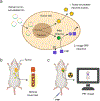Minicircles for a two-step blood biomarker and PET imaging early cancer detection strategy
- PMID: 34029631
- PMCID: PMC8262353
- DOI: 10.1016/j.jconrel.2021.05.026
Minicircles for a two-step blood biomarker and PET imaging early cancer detection strategy
Abstract
Early cancer detection can dramatically increase treatment options and survival rates for patients, yet detection of early-stage tumors remains difficult. Here, we demonstrate a two-step strategy to detect and locate cancerous lesions by delivering tumor-activatable minicircle (MC) plasmids encoding a combination of blood-based and imaging reporter genes to tumor cells. We genetically engineered the MCs, under the control of the pan-tumor-specific Survivin promoter, to encode: 1) Gaussia Luciferase (GLuc), a secreted biomarker that can be easily assayed in blood samples; and 2) Herpes Simplex Virus Type 1 Thymidine Kinase mutant (HSV-1 sr39TK), a PET reporter gene that can be used for highly sensitive and quantitative imaging of the tumor location. We evaluated two methods of MC delivery, complexing the MCs with the chemical transfection reagent jetPEI or encapsulating the MCs in extracellular vesicles (EVs) derived from a human cervical cancer HeLa cell line. MCs delivered by EVs or jetPEI yielded significant expression of the reporter genes in cell culture versus MCs delivered without a transfection reagent. Secreted GLuc correlated with HSV-1 sr39TK expression with R2 = 0.9676. MC complexation with jetPEI delivered a larger mass of MC for enhanced transfection, which was crucial for in vivo animal studies, where delivery of MCs via jetPEI resulted in GLuc and HSV-1 sr39TK expression at significantly higher levels than controls. To the best of our knowledge, this is the first report of the PET reporter gene HSV-1 sr39TK delivered via a tumor-activatable MC to tumor cells for an early cancer detection strategy. This work explores solutions to endogenous blood-based biomarker and molecular imaging limitations of early cancer detection strategies and elucidates the delivery capabilities and limitations of EVs.
Keywords: Biomarkers; Cancer detection; Minicircles; Reporter genes.
Copyright © 2021 Elsevier B.V. All rights reserved.
Conflict of interest statement
Author Conflict of Interest
S.S.G. was a co-founder and held equity in Earli Inc., which works in the field of early cancer detection; S.S.H. is a consultant for Earli Inc. No potential conflicts of interest were disclosed by the other authors.
Figures




Similar articles
-
Thymidine Kinase PET Reporter Gene Imaging of Cancer Cells In Vivo.Methods Mol Biol. 2018;1790:137-151. doi: 10.1007/978-1-4939-7860-1_11. Methods Mol Biol. 2018. PMID: 29858789
-
Synthesis and Characterization of 9-(4-[18F]Fluoro-3-(hydroxymethyl)butyl)-2-(phenylthio)-6-oxopurine as a Novel PET Agent for Mutant Herpes Simplex Virus Type 1 Thymidine Kinase Reporter Gene Imaging.Mol Imaging Biol. 2020 Oct;22(5):1151-1160. doi: 10.1007/s11307-020-01517-5. Mol Imaging Biol. 2020. PMID: 32691392
-
BIRC5 is a target for molecular imaging and detection of human pancreatic cancer.Cancer Lett. 2019 Aug 10;457:10-19. doi: 10.1016/j.canlet.2019.04.036. Epub 2019 May 3. Cancer Lett. 2019. PMID: 31059751
-
Second-generation triple reporter for bioluminescence, micro-positron emission tomography, and fluorescence imaging.Mol Imaging. 2006 Oct-Dec;5(4):465-74. Mol Imaging. 2006. PMID: 17150159
-
Molecular imaging of brain tumors personal experience and review of the literature.Curr Mol Med. 2008 Dec;8(8):711-26. doi: 10.2174/156652408786733766. Curr Mol Med. 2008. PMID: 19075670 Review.
Cited by
-
Revealing two distinct molecular binding modes in polyethyleneimine-DNA polyplexes using infrared spectroscopy.Soft Matter. 2025 May 28;21(21):4192-4200. doi: 10.1039/d5sm00213c. Soft Matter. 2025. PMID: 40326406 Free PMC article.
-
Targeting and monitoring ovarian cancer invasion with an RNAi and peptide delivery system.Proc Natl Acad Sci U S A. 2024 Mar 12;121(11):e2307802121. doi: 10.1073/pnas.2307802121. Epub 2024 Mar 4. Proc Natl Acad Sci U S A. 2024. PMID: 38437557 Free PMC article.
-
The Need to Pair Molecular Monitoring Devices with Molecular Imaging to Personalize Health.Mol Imaging Biol. 2022 Oct;24(5):675-691. doi: 10.1007/s11307-022-01714-4. Epub 2022 Mar 7. Mol Imaging Biol. 2022. PMID: 35257276 Free PMC article. Review.
-
Ultrasensitive Surface Plasmon Resonance Sensor with a Feature of Dynamically Tunable Sensitivity and High Figure of Merit for Cancer Detection.Sensors (Basel). 2023 Jun 14;23(12):5590. doi: 10.3390/s23125590. Sensors (Basel). 2023. PMID: 37420756 Free PMC article.
-
BRET Sensors for Imaging Membrane Integrity of Microfluidically Generated Extracellular Vesicles.Methods Mol Biol. 2022;2525:227-238. doi: 10.1007/978-1-0716-2473-9_17. Methods Mol Biol. 2022. PMID: 35836072
References
Publication types
MeSH terms
Substances
Grants and funding
LinkOut - more resources
Full Text Sources
Other Literature Sources
Medical

